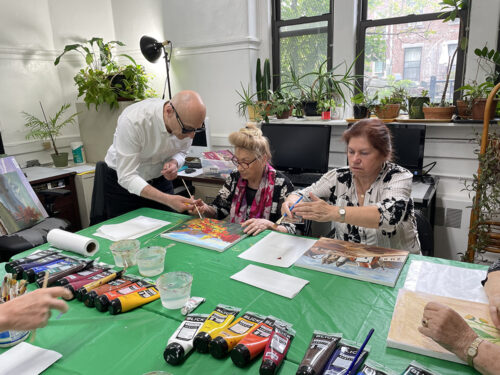
GREENPOINT — Christopher Zacharow came to the U.S. from his native Poland in 1981 with just $500 in his pocket and big dreams of making it as an artist. Less than a decade later, artwork he created depicting the collapse of the Soviet Union graced the cover of Time magazine.
From those youthful dreams, Zacharow, who is now 68, has carved out a successful career as a painter and illustrator with an enormous body of work that has been featured in magazines and newspapers like Time, The New York Times, Business Week, U.S. News & World Report, Newsweek, The Atlantic, and Psychology Today.
He’ll be the first to tell you that his dreams came true not just through talent and hard work but because of a little bit of luck and a lot of divine intervention.
“God was on my side, helping me along the way,” said Zacharow, who is Catholic.
His paintings have been shown in galleries in New York, Chicago, and in cities in Canada and Europe, including Krakow, where he studied art back in the 1970s. Over the years, he has received numerous awards for his work, such as the Silver Medal from the Society of Illustrators of New York.
Zacharow is a visiting art professor at Pratt Institute in Brooklyn, an illustration instructor at Parsons School of Design, and a painting lecturer at the Cooper Union.
But one of Zacharow’s favorite places to spend time is the Pete McGuinness Older Adult Center in Greenpoint, run by Catholic Charities Brooklyn & Queens. Twice a month, he teaches senior citizens how to paint.
While class size fluctuates, there is a small group of regulars — five or six students — who consistently show up.
Zacharow gently guides the students who work with acrylic to paint rural scenes, flowers, still lifes, and portraits.
He loves teaching at the center and feels he is getting as much out of the classes as the students. “They have changed me and enriched me. Their enthusiasm makes me enthusiastic. They’re like big kids,” he said.
His students love the class and love learning from him.
“He is the best teacher! I came here with almost no knowledge about painting. And I have learned a lot,” said Malgorzata Tambor, who showed The Tablet a scene she painted of a small village in her native Poland.
Luiza Niespor wanted to paint from childhood but really didn’t pursue it. She started coming to Zacharow’s class last fall. “At first, I didn’t believe in myself. But he helps us a lot. We need a guide, and he is good at that,” she said.
Zacharow was born in Zamosc, a city in eastern Poland, approximately 165 miles from Warsaw. His hometown’s Italian Renaissance architecture inspired him.
“I was exposed to great art,” he recalled. “I started drawing and carving at 5 years old, believe it or not. My mother would give me potatoes, and I would carve things with them.”
He studied painting at the Academy of Fine Arts in Krakow, graduating in 1979, and then left Poland for the U.S. two years later, determined to make a life for himself as an artist.
Through a chance meeting with a man who had a spare room in his Lower East Side apartment, Zacharow quickly found a place to live shortly after his arrival.
New York in the 1980s had high crime and a crack epidemic, but the stock market was riding high, and newly minted Wall Street tycoons were looking for paintings to decorate their Park Avenue duplexes. At the same time, artists were beginning to move into lofts in SoHo and were more than happy to sell their work.
While out with friends in a bar, he met a woman who, as it turned out, was the manager of an art gallery on Madison Avenue, who hired him to paint silhouettes. “I spent maybe two hours doing it. I got $1,000. Big money,” he recalled.
He kept perfecting his work and eventually got the opportunity to be hired by magazines to illustrate articles as well as magazine covers.
In 1988, he drew a cover for Time magazine depicting the Soviet Union as a giant puzzle coming apart. Time later donated the original illustration to the National Portrait Gallery in Washington, D.C.
Zacharow has made a living as an illustrator, selling his work to magazines and book publishing houses.
But he always kept his eye on the ball. “My career as an illustrator has been parallel with my work in fine art,” he explained. “I never stopped doing my fine art. Illustration was the best way to earn money to support my art.”
It is something he tries to instill in his college students as well as the older adults at the Pete McGuinness Older Adult Center — never give up on dreams.
